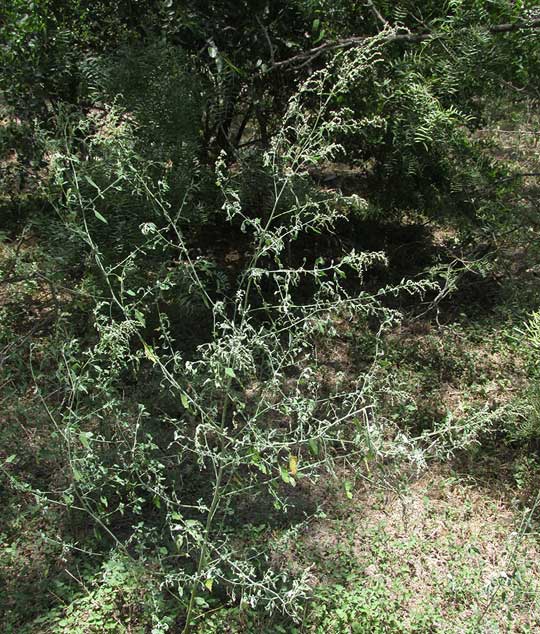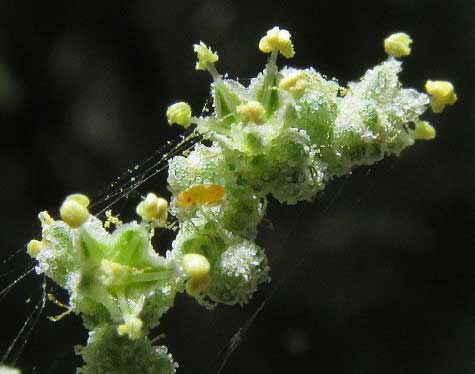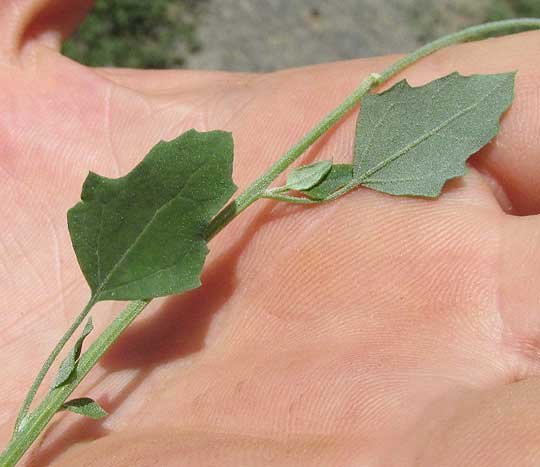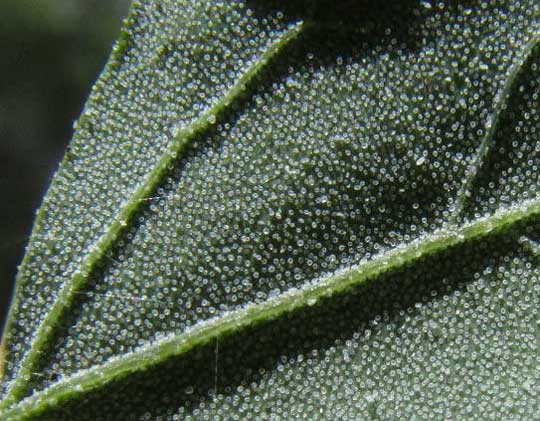Excerpts from Jim Conrad's
Naturalist Newsletter
from the August 10, 2014 Newsletter issued from the Frio Canyon Nature Education Center in the valley of the Dry Frio River in northern Uvalde County, southwestern Texas, on the southern border of the Edwards Plateau; elevation ~1750m (~5750 ft); N29.62°, W99.86°; USA
LAMBSQUARTERS
Along trails through Cook's Slough Nature Park on Uvalde's south side and along roadsides, up against fences, etc. , nowadays there's a weedy plant that, especially after midday when it's starting to pucker and twist because of the dryness, is so unspectacular, spindly and scrappy looking that if you're really hot and sweaty and looking for shade, you're more likely to pass it by than take a closer look. You can see one of these exceptionally homely-looking weeds below:

Even with this distant glance, the manner by which its top branches end with unkempt, elongate clumps of tiny, greenish, granular items, someone familiar with weeds might recognize this as Lambsquarters, Chenopodium album, a common weed throughout North America, and famous for its young stems and leaves being eminently edible when cooked like spinach. However, these Cook's Slough plants were taller, more diffusely branched and more wiry than the Lambsquarters I'm accustomed to back East, so I took a closer look. The flowering heads certainly looked like the East's Chenopodium album, as shown below:

Those flowering heads consist almost entirely of flower buds, not open flowers. However, on one plant in the shade a few buds were open, so, below, you can see that the tiny flowers consist of a corolla-like, five-parted calyx heavily coated with tiny, white, gland-like hairs -- there being no corolla -- and the five stamens arise opposite the calyx lobes, or sepals:

All this is hardly indistinguishable from the Lambsquarters I so frequently eat back East. However, the leaves look different. Leaves of these Texas plants strike me as being, on the average, smaller and more deeply toothed, as shown below:

Like the Lambsquarters back East, the leaves are heavily covered with a white mealiness, as shown below:

Surfaces covered with such white mealiness are said to be "farinose," the word farinose being based on the Latin farina, which simply means ground corn or flour, or meal.
So, our Cook's Slough plants are Lambsquarters, but they're a different Lambsquarters species from the abundant one I've so often eaten. Our Cook's Slough plants are CHENOPODIUM BERLANDIERI, occurring throughout North America, though most commonly in the west and central parts, and curiously absent from most of the US Southeast, but extending southward from here through northern and central Mexico.
Our Cook's Slough Lambsquarters goes by several names, such as Pigweed, Pitseed Goosefoot and Huauzontle. And, amazingly, this Lambsquarters species is a very important one in terms of its contributions to native American cultures. For, Chenopodium berlandieri is one of only four plants that were domesticated in the Eastern Woodlands of North America prior to the introduction of corn, or maize. Archaeological evidence shows that the species was extensively foraged by people in eastern North America as early as 8,500 years ago. By 3700 years ago the plant had been domesticated.
Nowadays a cultivar of our plant, Chenopodium berlandieri subsp. nuttalliae, originally grown in Mexico, is grown commercially for its green and red foliage and is served in salads at restaurants under the name Red Aztec Spinach. In Mexico other cultivars of this same subspecies are still grown for their edible grains.
You may be interested in Daniel Robinson's Masters Thesis at the University of Tennessee, "Chenopodium berlandieri and the Cultural Origins of Agriculture in the Eastern Woodlands," available for free on the Internet. To find it, search on the title.
Though the Lambsquarters at Cook's Slough were too mature and thus too tough, I read that earlier in the year the young plants and sprouts of this species are just as good to eat as the Lambsquarters I'm used to in the East. That makes this a plant to know, and to wait for next spring.